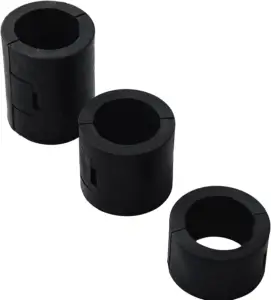An oft-overlooked problem in the realm of office chair usage is the ever-frequent issue of the chair not maintaining its intended height, instead sinking with each passing moment. The source of this common inconvenience is a failure in the pneumatic cylinder system, which operates via pressurized air to provide the user with control over the chair’s positioning.
Over time, the incessant weight and pressure imposed upon the chair’s structure lead to the inevitable breakdown of the cylinder, causing the sinking phenomenon to occur. But fear not, dear reader, for there exist several potential remedies to rectify this vexing issue and restore your chair to its rightful glory.

Perhaps the most drastic of solutions, but one that could potentially prove effective is to replace the pneumatic cylinder system outright. However, be warned that this approach is both exorbitantly expensive and complex, with many an average user choosing instead to purchase a completely new chair.
5 ways DIY solution
But what if one wishes to attempt a more DIY-oriented solution? Well then, one must first gather the requisite tools necessary for the specific repair method of their choosing.
The materials and equipment
The materials and equipment needed will vary depending on the approach selected, but generally speaking, a screwdriver, rubber strip, duct tape or sandpaper, jubilee clip, hose clamp, and grease remover or cleaning agent will be required for hose clamping.
For those interested in the PVC piping method, a tape measure or ruler, PVC pipe identical in size to the chair’s cylinder, a cutting tool such as a hacksaw or band saw, and a vise will be necessary.
Finally, replacing the cylinder will necessitate a rubber mallet, pipe wrench, new pneumatic cylinder, screwdriver, and perhaps even some WD-40 in case of difficulty in separating the various components of the chair.
With the proper tools and knowledge at your disposal, you can take the reins and reclaim control over your work environment.
How to fix
If you’re facing the issue of an office chair that keeps sinking, worry no more. Fixing this problem can be done in various ways, but two of the most common methods are hose clamping and using PVC piping. Both approaches have their benefits and drawbacks, so it’s best to consider which one suits you best before proceeding.
1# Hose clamping
Hose clamping involves a bit of work and patience, but the results are worth it. First, you need to lay your chair down so you can work on it properly.
Then, you need to move the plastic skirt up or down to reveal the pneumatic cylinder underneath. Set the chair to your desired height and ensure that you can see the metal cylinder.
If not, remove the plastic skirt to make your work easier. If the cylinder looks dirty or rusty, clean it up. Wipe it down to remove dust or use sandpaper to scuff it up or a grease remover if needed.
Take your duct tape and wrap it around the exposed cylinder to provide a tight grip for the hose clamp. Wrap the hose clamp around the cylinder at the top point and adjust it in position.
Countercheck if the chair is at the right height before pushing the hose clamp up as you tighten the clamping bolts.
Tighten the hose clamp around the cylinder as much as possible to keep it up in place when you sit. Try out the chair and ensure that it doesn’t go past the clamp.
If it moves downward, that means you haven’t tightened it properly. If the clamp keeps sliding off, try adding a rubber strip before tightening the clamp over it.
2# Use PVC piping
Using PVC piping is another method that can fix your sinking office chair. Just like in the first step, lay your chair down if it doesn’t hold, and move the plastic skirt up or down to leave parts of the cylinder exposed. Use your ruler to estimate the diameter of the cylinder, which will help you choose the right size of PVC pipe.
Adjust the office chair to a suitable height, and then measure the circumference and length of the exposed gas cylinder. Get a PVC pipe with the same length and slightly bigger diameter than the chair cylinder. You can choose to work with it as a whole or chop it into several pieces.

Cut through the PVC pipe along its length using a hacksaw or any cutting solution you have. The result should be a pipe with a slit on one side. If you don’t want to cut the PVC pipe, remove the base of your office chair and insert your pipe to fit the length of the cylinder. Take and pull the slits open then snap them around the metal cylinder.
If it seems impossible to snap your pipes around the chair, cut them into even shorter pieces to make the process easier. Once the snapping is done, your chair is ready to use. If you want to raise the chair higher, add more pipes. If the height of the office chair is too high, and you want to make them shorter, remove a few pipes until you get a comfortable height.
3# Make repairs in an instant with the Chair Saver Kit
The Chair Saver Kit is a wondrous invention that enables you to revive your submerging chair in mere minutes. The intricate kit comes equipped with a spacer ring that resembles a curious geometric shape, and this is the key to its remarkable restorative powers.
It’s a cinch to use: Simply snap the spacer rings onto the piston of your current gas cylinder lift, and voila! The spacers will bolster the seat pan and work in tandem with the cylinder lift to lift your sinking chair back to its former glory. Fear not, as the spacers have been imbued with extraordinary strength and are more than capable of supporting the weight of your corporeal form.

To achieve optimal ergonomics, stack spacers until the seat pan reaches the zenith of your standing knee height. A feat that can be accomplished with startling ease in a mere matter of moments.
And the price? A mere pittance! The Chair Saver Kit is a cheap purchase, and it boasts a warranty that spans five full years, an impressive testimony to the manufacturer’s unwavering faith in its durability. Since they are universal, it would behoove you to purchase a large quantity of spacers to have on hand for future use. That way, when one of the rings fractures or you require a greater seat height, you can readily and effortlessly replace it.
Gone are the days when you must disassemble your chair entirely to effect such repairs. The Chair Saver Kit makes it all too easy to restore your throne to its former magnificence without breaking a sweat.
4#Replace the Gas Cylinder
While the methods we previously discussed may yield some temporary success, they may not provide the long-term solution you desire. Not to mention, they could also compromise the structural integrity of your beloved office chair.
To avoid such risks, the optimal course of action is to purchase a new system and install it. If you know the specific brand of your office chair, it is recommended to select a corresponding cylinder from the same brand. However, if you are unsure about your chair’s brand, don’t worry! You can always reach out to us for assistance in identifying it.

Once you have obtained the appropriate cylinder, it’s time to begin the installation process. First, lay your chair down on its side and tap its base with a rubber mallet to disengage the old cylinder from the chair. Next, unscrew the bolts under the seat and grip the cylinder with a wrench from the end closest to the chair as you twist it to detach it from the rest of the chair. If the cylinder doesn’t separate as expected, you can use the mallet to gently tap it off.
If you encounter difficulty in removing any of these chair components, applying WD-40 and letting it sit for a while before attempting removal again may prove helpful. However, make sure to cover any surrounding objects in your work area to avoid damaging them with the WD-40.
After successfully detaching the old cylinder from the chair, it’s time to replace it with the new one. Simply insert the new cylinder under your chair and bolt it back into position. Then, attach the chair to the base and test it by setting it upright to ensure that the installation was successful.
5# Professional Repair Cost
Of course, we understand that some folks are understandably skeptical about repairing their sinking office chairs. Fortunately, professionals can lend a hand. For a nominal fee of approximately $40, they can replace the gas cylinder in your office chair and ensure that it is once again functional and ready for action. So, if you’re feeling uncertain about your own DIY capabilities, why not leave it to the experts?







